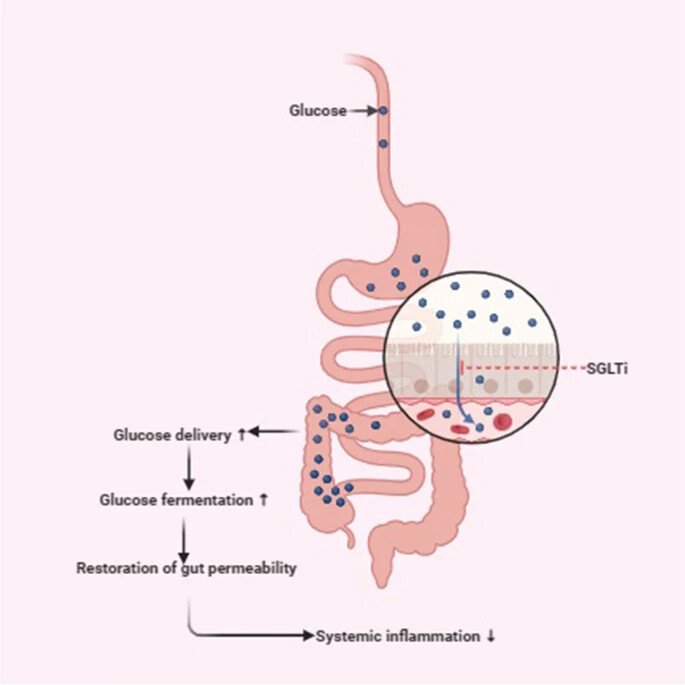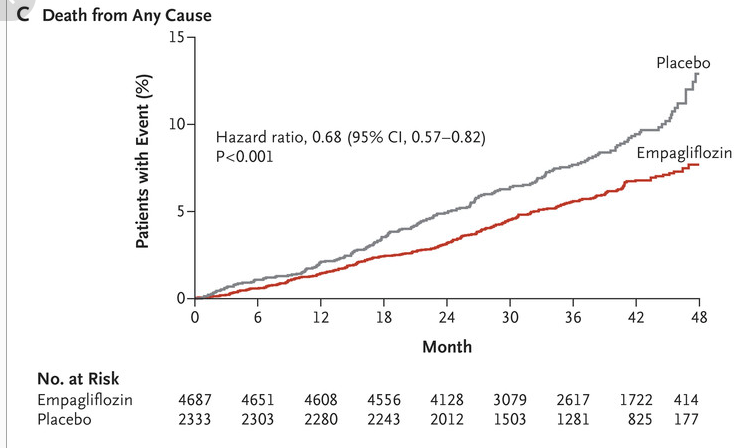Highly unlikely IMO.
I have been using metformin for decades and have experimented with various dosing levels and have never experienced dangerously low blood glucose levels. Maybe people who have type II diabetes react differently to metformin.
Does anyone see a “conflict of interest” between metformin and Jardiance? Would it be unhealthy to use both?
The times when I have experienced hypoglycemia has been while taking a relatively high dosage of Metformin (1.5-2 g daily). I would get hit with hypoglycemia at around 4 pm on regular occasions. It feels like a heart attack but goes away in a few minutes if you take sugar. If I don’t take high levels of Metformin, I don’t experience the issue.
My doctor told me it was hypoglycemia, so that’s what I have assumed.
I think you mean drug interaction. It’s used in a combination pill. Metformin isn’t that good though, except for those it is indicated of course…?
Well, actually I am looking more for “is there any synergies” or they both work on their own way. I tend to say things not so directly from time to time. Anyway, As far as interaction I don’t think there any interaction. Since we are on the subject does acarbose makes sense to be taken in addition to Jardiance?
See this thread for a past discussion on this question: Combination of Rapamycin, Acarbose, and SGLT-2 inhibitor
I eat four meals per day. I take 10mg Empagliflozin with breakfast, then 50mg Acarbose with each of the following three meals (150mg total). I would imagine it’s synergistic. I believe they are prescribed together sometimes.
Great info on this thread. Exactly what I was looking for. Thanks,
Another possible mechanism behind SGLT2 benefits is increased magnesium levels. I wonder if we can get away with consuming slightly less magnesium if we take an SGLT2, saving money on a magnesium supplement.
Unless you are consuming magnesium by Lb per day, I doubt you’d save much but interesting to know SGLT2’s help increase magnesium levels.
This database at the website “Drugs@FDA: FDA-Approved Drugs” has a wealth of information, here for empagliflozin:
Approval Date(s) and History, Letters, Labels, Reviews for NDA 204629 [empagliflozin]
I am looking for data on efficacy of doses lower than 10 mg like 6.25 mg.
Great review: Applications of SGLT2 inhibitors beyond glycaemic control 2024
Sodium–glucose cotransporter 2 (SGLT2) inhibitors reduce the risk of kidney disease progression in people with or without diabetes as well as the risk of acute kidney injury and hyperkalemia.
SGLT2 inhibitors reduce the risk of cardiovascular death and heart failure hospitalization among people with type 2 diabetes mellitus and have beneficial effects on key heart failure outcomes irrespective of diabetes status or left ventricular ejection fraction.
SGLT2 inhibitors modestly lower systolic and diastolic blood pressure without a significant increase in risk of hypotensive episodes and have modest benefits for weight loss.
Other benefits of SGLT2 inhibitors include improvements in liver outcomes in people with metabolic dysfunction-associated steatotic liver disease, reduced risk of symptomatic kidney stone events, improvements in anaemia outcomes and potential reductions in the risk of new-onset atrial fibrillation and new-onset diabetes.
SGLT2 inhibitors have a generally favourable adverse effect profile but are associated with increased risk of genital mycotic infections and a small increased risk of diabetic ketoacidosis; they should be used with caution in people with unstable volume status owing to the risk of hypovolemia.
Prescription of SGLT2 by clinicians and patient adherence are suboptimal despite strong evidence for the efficacy and cost-effectiveness of these therapies.
SGLT2-independent effects of canagliflozin on NHE3 and mitochondrial complex I activity inhibit proximal tubule fluid transport and albumin uptake 2024 (@Neo)
Strikingly, canagliflozin but not empagliflozin reduced fluid transport across cell monolayers, and dramatically inhibited endocytic uptake of albumin. These effects were independent of glucose and occurred at clinically relevant concentrations of drug.
Mice given a single dose of canagliflozin excreted twice as much urine over 24 h compared with empagliflozin-treated mice despite similar water intake.
Though sodium-glucose co-transporter-2 inhibitors (SGLT2i) increase the risk of mycotic genital infections (MGI) and possibly urinary tract infections (UTI), their cardiovascular benefits in patients with heart failure far outweigh those risks.
Currently, the mechanism of the protective effect of SGLT2 inhibitors on myocardial infarction is not yet understood.
Mendelian randomization analysis uncovered a causality between SGLT2 inhibition and myocardial infarction.
Based on proteome-wide mendelian randomization, APOB and CCL17 were seen as mediators in the protective effect of SGLT2 inhibition against myocardial infarction.
The impact of sodium-glucose cotransporter inhibitors on gut microbiota: a scoping review 2024

Not a great paper, but funny finding: Effect of sacubutril/valsartan and dapagliflozin on athletic performance; Can the popular cardiac medications of recent years be used as doping agents? 2024
In the study, the swimming performances of three groups of rats were evaluated by dividing them into control, sacubitril/valsartan and dapagliflozin groups. […] In the comparison of dapagliflozin and control groups, a statistical difference was observed starting from the 10th swimming session, and when the total and average swimming times were compared, the p values were <0.001 and <0.001. In triple analysis, a statistical difference was seen from the 9th swimming session until the end of the experiment. […] Our study showed a limited positive effect of sacubitril/valsartan on athletic performance. The impact of dapagliflozin on athletic performance was shown to be particularly significant.
The results show that DAPA promotes WAT “browning” and improves metabolic disorders. […] These findings provide a rational basis for the use of DAPA in treating obesity by promoting the browning of white adipose tissue.
SGLT-2 Inhibitors: Focus on Dapagliflozin 2024
Comparative analysis with other SGLT-2 inhibitors suggests dapagliflozin’s potential superiority in preventing heart failure. Compared to empagliflozin, it has more extended effects, contributing to stable sodium diuresis, reduced blood pressure fluctuations, and potentially lower cardiovascular disease risks. However, it leads to less urinary glucose excretion compared with canagliflozin.
Compared with GLP-1 receptor agonists, the SGLT-2 inhibitor-GLP-1 receptor agonist combination was associated with a 30% lower risk of major adverse cardiovascular events (7.0 v 10.3 events per 1000 person years; hazard ratio 0.70, 95% confidence interval 0.49 to 0.99) and a 57% lower risk of serious renal events (2.0 v 4.6 events per 1000 person years; hazard ratio 0.43, 0.23 to 0.80). Compared with SGLT-2 inhibitors, the GLP-1 receptor agonist-SGLT-2 inhibitor combination was associated with a 29% lower risk of major adverse cardiovascular events (7.6 v 10.7 events per 1000 person years; hazard ratio 0.71, 0.52 to 0.98), whereas serious renal events generated a wide confidence interval (1.4 v 2.0 events per 1000 person years; hazard ratio 0.67, 0.32 to 1.41).
In this cohort study, the GLP-1 receptor agonist-SGLT-2 inhibitor combination was associated with a lower risk of major adverse cardiovascular events and serious renal events compared with either drug class alone.
Great post @adssx
Can anyone access this one - would be very valuable to see how much of this effect is SGLT1i driven vs by SGLT2i
Unfortunately, empagliflozin failed to affect outcomes in a new trial of heart attack survivors. I haven’t dug into the details yet, but with a mean follow up of 18 months and all of the positive effects we’ve seen in other trials, I sure would have expected to see better results.
I do wonder if the 10mg dose was too low.
https://www.medscape.com/viewarticle/empagliflozin-fails-reduce-events-after-acute-mi-2024a10006kn
Them too, which is probably why we saw a negative result, it was under-powered for the composite heart failure + ACM? 10 mg is about as effective as 25 mg so it is unlikely that played a role.
10mg is about as effective as 25mg for diabetes, but is it established that 10mg is as effective for heart failure and other potential cardiovascular benefits?
This is a good point. Dapagliflozin 10 mg (equivalent to empagliflozin 25 mg) succeeded where empagliflozin failed. Also, the survival curve for empagliflozin 10 mg looks good and I wonder if 6 more months could have reached significance. See more on these trials here: Canagliflozin - Another Top Anti-aging Drug - #703 by adssx
Yes, there isn’t a large difference for outcomes.
Empagliflozin, Cardiovascular Outcomes, and Mortality in Type 2 Diabetes: https://www.nejm.org/doi/full/10.1056/NEJMoa1504720
A longer trial seems what the people in the medscape article, who might be the researchers, think.
It kind of looks like an exponential curve in the empa trial I linked where placebo really takes off towards the end.
I would call this pretty significant, it seems that with empa the number drops from about 14 to 8 which is about 40% drop, not too shabby if you ask me and that is for 48 months which as someone rightly noted the benefit seems to increase as time passes, so at perhaps longer intervals the benefits might get even more significant.
We’re talking about different trials and statistical significance not clinical significance. The study I linked and showed a graph from was statistically significant. The point is it was very long (48 months), compared to the other one (18 months).
